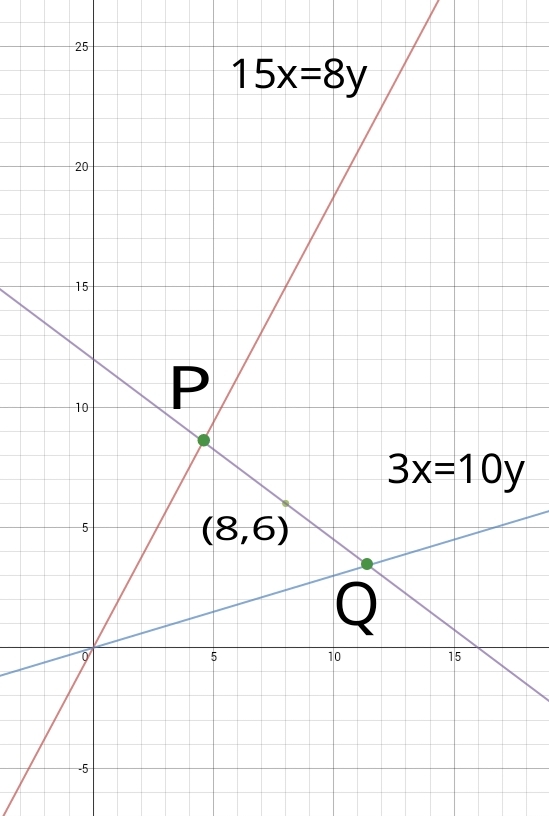JEE Main 2016 (12)
The straight lines 1 5 x = 8 y , 3 x = 1 0 y contain points P , Q respectively. If the midpoint of P Q is ( 8 , 6 ) , then the length of P Q = n m reduced fraction, then m − 8 n is
Try my set JEE main 2016
This section requires Javascript.
You are seeing this because something didn't load right. We suggest you, (a) try
refreshing the page, (b) enabling javascript if it is disabled on your browser and,
finally, (c)
loading the
non-javascript version of this page
. We're sorry about the hassle.
2 solutions

Let,
P = ( x 1 , y 1 ) and Q = ( x 2 , y 2 ) .
According to mid point formula (corollary of section formula ),
2 x 1 + x 2 = 8 ... ( 1 ) and 2 y 1 + y 2 = 6 ... ( 2 )
x 1 + x 2 = 1 6 and y 1 + y 2 = 1 2
Also, 1 5 x 1 = 8 y 1 and 3 x 2 = 1 0 y 2 .
Hence ( 2 ) can be written as 8 1 5 x 1 + 1 0 3 x 2 = 1 2 .
Solving ( 1 ) and ( 2 ),
We get x 1 = 7 3 2 , x 2 = 7 8 0 , y 1 = 7 6 0 and y 2 = 7 2 4 .
Applying distance formula,
P Q = ( 7 3 2 − 7 6 0 ) 2 + ( 7 8 0 − 7 2 4 ) 2
P Q = 7 6 0 = n m
Now,
m − 8 n = 4
Let P(Xq,Yq). Q(Xq,Yq). So from midpoint formula X p + X q = 1 6 , and Yp+Yq=12, that is 8 1 5 ∗ X p + 1 0 3 ∗ X q = 1 2 . S o − 1 2 X p − 1 2 X q = − 1 9 2 , a n d 7 5 X p + 1 2 X q = 4 8 0 , g i v e s 6 3 X p = 2 8 8 . ⟹ X p = 7 3 2 . ∴ Y p = 7 3 2 ∗ 8 1 5 = 7 6 0 . P Q = 2 ∗ { ( X p , Y p ) t o ( 8 , 6 ) } ∴ P Q = 2 ∗ ( 8 − 7 3 2 ) 2 + ( 6 − 7 6 0 ) 2 = 7 1 2 4 2 + 3 2 = 7 6 0 = n m . m − 8 n = 6 0 − 5 6 = 4 .